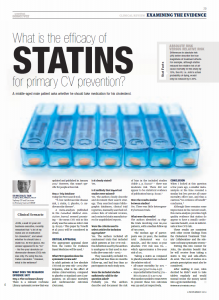 This article was published in Medical Observer.
This article was published in Medical Observer.
The article is also available on the Medical Observer website (may need registration).
Clinical scenario
John, a well 52-year old business executive, recently remarked that “a lot of my mates are on Crestor”, and asked whether he should take a statin too. At first glance, the answer appeared to be “no” – his 5-year absolute cardiovascular disease (CVD) risk was only 3% using the Australian calculator. [1] However, what is the evidence?
Clinical question
What is the efficacy of statins when used for primary prevention in people at low absolute risk of cardiovascular disease?
What does the research evidence say?
Step 1: The Cochrane Library
There is a relevant Cochrane Library systematic review that was updated and published in January 2013. [2] However, this wasn’t specific for people at low risk.
Step 2: Trip Database
I used the PICO search tool – “P: low cardiovascular disease risk, I: statin, C: placebo, O: cardiovascular disease”.
A meta-analysis published in the Canadian Medical Association Journal seemed promising – the mean CVD risk in this study was the same as John’s risk (p. E1192). [3] Let’s look at the paper by Tonelli et al. (2011) in detail.
Critical appraisal
I will use the appropriate appraisal sheet from the Centre for Evidence Based Medicine. [4]
What PICO question does the systematic review ask?
In adult patients at low absolute CVD risk (10-year risk < 20%) (Participants); what is the effect of statins (Intervention); compared to placebo or standard care (Comparator); on all-cause mortality and cardiovascular outcomes (Outcome).
Is it clearly stated?
Yes.
Is it unlikely that important studies were missed?
Yes. The authors clearly describe and document their search strategy. They searched major bibliographic databases, clinical trial registries, manually searched reference lists of relevant reviews, and contacted statin manufacturers for unpublished reports.
Were the criteria used to select articles for inclusion appropriate?
Yes. The authors included all randomised trials that included adult patients at low CVD risk – the definition used by the authors is analogous to that used in Australia (5-year risk < 10%). [1] They reasonably excluded trials that had less than 6-months follow-up, and had less than 30 participants in each study arm.
Were the included studies sufficiently valid for the question asked?
Probably yes. The authors describe and document the risk of bias in the included studies (Table 2, p. E1202) [3] – there was moderate risk. There did not appear to be statistical evidence of publication bias (p. E1191). [3]
Were the results similar between studies?
Yes. There was little heterogeneity between trials.
What were the results?
The authors identified 29 eligible trials involving over 80,000 patients, with a median follow up of 2 years. The median age of participants was 58 years, the median total cholesterol was 6.0 mmol/L, and the mean 10-year absolute CVD risk was 6% – which approximates a 5-year risk of 3%.
Taking a statin as compared to placebo/standard care reduced the relative risk of:
- all-cause mortality by 10% – RR 0.90 (95% CI 0.84-0.97)
- myocardial infarction by 37% – RR 0.63 (95% CI 0.50-0.79)
The number needed to treat (NNT) to prevent these two outcomes was 239 and 216 respectively.
Conclusion
When I looked at this question a few years ago, a smaller meta-analysis at the time revealed a similar but less precise all-cause mortality effect size, and thus a cautious “no evidence of benefit” conclusion. [6] Although there remains some imprecision in the current result, this meta-analysis provides high quality evidence that statins do appear to have a (small) cardiovascular benefit, even in individuals at low CVD risk. These results are consistent with other recent findings from the Cholesterol Treatment Trialists’ Collaboration [5] and the relevant Cochrane systematic review. [2]
Putting this into context for John, the absolute benefit that he will receive from taking a statin is tiny and side-effects do exist. The cost of statins on a private prescription must also be considered.
After mulling it over, John decided that he didn’t, in fact, want to take tablets regularly and decided to invest the money saved into a gym membership. In my opinion, a wise choice!
Stat Facts
Absolute risk versus relative risk
Differences in absolute risk (AR) better describe the true magnitude of treatment effects. For example, although statins reduced the relative risk of all-cause mortality in this study by 10%, the AR, i.e., John’s actual probability of dying, would only be reduced by 0.42%.
References
- National Vascular Disease Prevention Alliance. Guidelines for the assessment of absolute cardiovascular risk. 2009
- Taylor F, Huffman MD, Macedo AF, Moore THM, Burke M, Davey Smith G, Ward K, Ebrahim S. Statins for the primary prevention of cardiovascular disease. Cochrane Database of Systematic Reviews 2013, Issue 1. Art. No.: CD004816. DOI: 10.1002/14651858.CD004816.pub5
- Tonelli M, Lloyd A, Clement F, Conly J, Husereau D, Hemmelgarn B, Klarenbach S, McAlister FA, Wiebe N, Manns B, Alberta Kidney Disease Network. Efficacy of statins for primary prevention in people at low cardiovascular risk: a meta-analysis. CMAJ 2011; 183(16): E1189-E1202. DOI: 10.1503/cmaj.111674
- Systematic Review: Are the results of the review valid? Centre for Evidence Based Medicine, University of Oxford. http://www.cebm.net/index.aspx?o=1157 Retrieved: 2013 October 2
- Cholesterol Treatment Trialists’ (CTT) Collaborators. The effect of lowering LDL cholesterol with statin therapy in people at low risk of vascular disease: meta-analysis of individual data from 27 randomised trials. Lancet 2012; 380(9841): 581-590. DOI: 10.1016/S0140-6736(12)60367-5
- Ray KK, Seshasai SRK, Erqou S, Sever P, Jukema JW, Ford I, Sattar N. Arch Intern Med 2010; 170(12): 1024-1031. DOI: 10.1001/archinternmed.2010.182

2 comments
Thanks Michael.
You have a great knack of cutting through the opinion and homing in on the evidence.
P.S. I it’s shameless opinion you’re after on the statin debate, mine is at The Conversation at http://theconversation.com/viewing-catalysts-cholesterol-programs-through-the-sceptometer-19817
Author
Your article on The Conversation has certain triggered some vigorous debate!